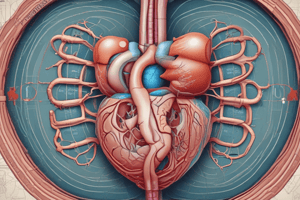Podcast
Questions and Answers
What is the primary function of the countercurrent multiplication process in the renal medulla?
What is the primary function of the countercurrent multiplication process in the renal medulla?
- To regulate blood pressure
- To filter blood and produce urine
- To control electrolyte balance
- To create an osmotic concentration gradient (correct)
What happens to the solute concentration of tubular fluid in the thin descending limb of the nephron loop?
What happens to the solute concentration of tubular fluid in the thin descending limb of the nephron loop?
- It increases due to water absorption
- It increases due to active transport
- It remains the same
- It decreases due to water absorption (correct)
What is the characteristic of the thick ascending limb of the nephron loop?
What is the characteristic of the thick ascending limb of the nephron loop?
- Permeable to water and actively transports solutes in
- Impermeable to water and actively transports solutes out (correct)
- Permeable to water and impermeable to solutes
- Impermeable to water and permeable to solutes
What is the role of the peritubular fluid in the nephron loop?
What is the role of the peritubular fluid in the nephron loop?
What is the outcome of the countercurrent multiplication process in the renal medulla?
What is the outcome of the countercurrent multiplication process in the renal medulla?
In which part of the nephron loop does water move from the tubular fluid into the peritubular fluid by osmosis?
In which part of the nephron loop does water move from the tubular fluid into the peritubular fluid by osmosis?
What is the primary reason for the increase in concentration of solutes within the tubular fluid?
What is the primary reason for the increase in concentration of solutes within the tubular fluid?
Which part of the nephron makes the final adjustments to the composition of the tubular fluid?
Which part of the nephron makes the final adjustments to the composition of the tubular fluid?
What is the effect of a decrease in the Na+ concentration of the filtrate on the pH of the tubular fluid?
What is the effect of a decrease in the Na+ concentration of the filtrate on the pH of the tubular fluid?
What is countercurrent multiplication in the kidneys?
What is countercurrent multiplication in the kidneys?
What substances are actively pumped into the peritubular fluid by the thick ascending limb of the nephron loop?
What substances are actively pumped into the peritubular fluid by the thick ascending limb of the nephron loop?
How does an increase in sodium and chloride ions in the peritubular fluid affect the descending thin limb?
How does an increase in sodium and chloride ions in the peritubular fluid affect the descending thin limb?
What is the primary driving force behind the production of filtrate in the glomerulus?
What is the primary driving force behind the production of filtrate in the glomerulus?
What is the purpose of the filtration slits in the podocytes?
What is the purpose of the filtration slits in the podocytes?
What is the result of the balance between glomerular hydrostatic pressure and blood colloid osmotic pressure?
What is the result of the balance between glomerular hydrostatic pressure and blood colloid osmotic pressure?
What is the name of the specialized basement membrane that forms part of the filtration membrane?
What is the name of the specialized basement membrane that forms part of the filtration membrane?
What is the term for the pressure produced by a fluid against a surface?
What is the term for the pressure produced by a fluid against a surface?
What is the name of the structure that receives the filtrate from the glomerulus?
What is the name of the structure that receives the filtrate from the glomerulus?
Flashcards are hidden until you start studying
Study Notes
Nephron Loop
- Osmotic concentration of peritubular fluid is increased due to the activity of the thick ascending limb
- Thin descending limb is permeable to water and impermeable to solutes, allowing water to move from tubular fluid into the peritubular fluid by osmosis
- Thin descending limb increases tubular fluid solute concentration
- Thick ascending limb actively transports solutes out of the tubular fluid, decreasing tubular fluid solute concentration and increasing peritubular fluid solute concentration
Countercurrent Multiplication
- Countercurrent multiplication occurs between the thin descending limb and thick ascending limb, which are located close to each other and separated by peritubular fluid
- Countercurrent multiplication is responsible for creating a concentration gradient in the renal medulla
- It enables the production of highly concentrated urine
Urine Concentration
- Water is reabsorbed along the DCT and collecting duct, increasing the concentration of solutes within the tubular fluid, particularly urea
- Tubular fluid reaching the papillary duct has a typical urea concentration of ~450 mOsm/L
Filtration
- Filtration occurs when the hydrostatic pressure produced by the heart pushes water and solutes through the filtration membrane
- Hydrostatic pressure is the pressure produced by a fluid against a surface
- The filtration membrane consists of:
- Fenestrated glomerular capillaries with large diameter pores
- Dense layer, a specialized basement membrane
- Filtration slits from podocytes
Factors Controlling Glomerular Filtration
- Glomerular hydrostatic pressure (GHP) pushes water and solutes out of plasma and into the filtrate
- Capsular colloid osmotic pressure opposes filtration
- Blood colloid osmotic pressure (BCOP) tends to draw water out of the filtrate and into the plasma
Studying That Suits You
Use AI to generate personalized quizzes and flashcards to suit your learning preferences.




